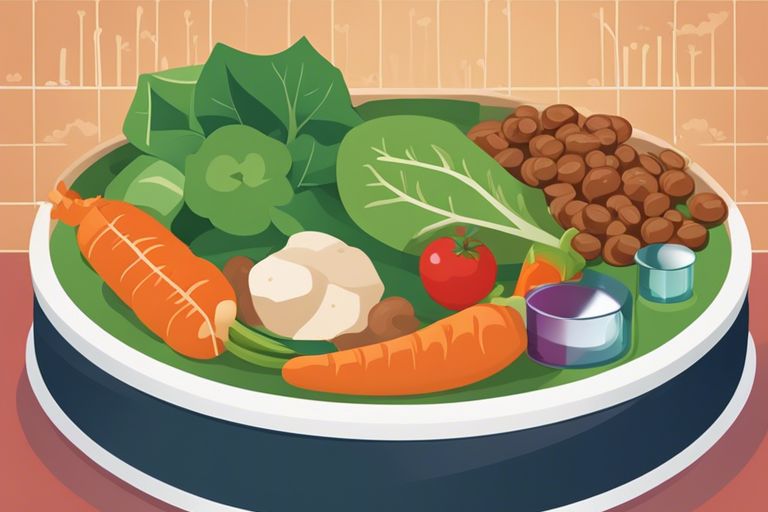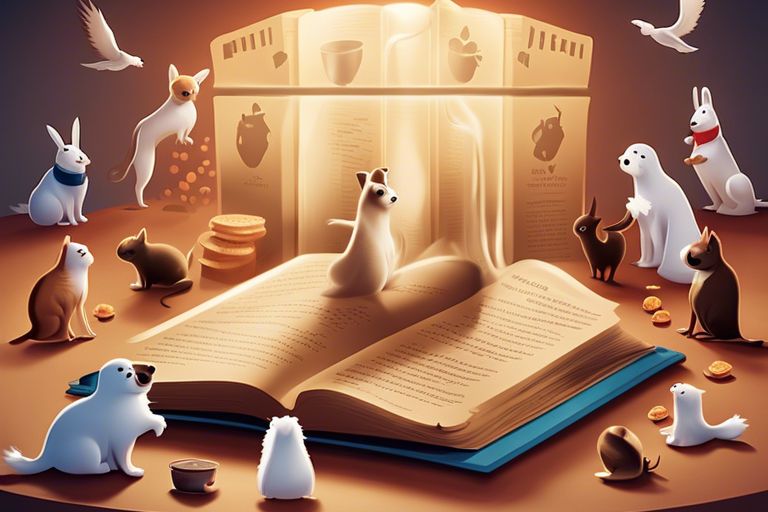Picking the appropriate nutrition for your beloved furry friend is no small task. With a multitude of options available on the market, it can be overwhelming to navigate the world of pet food. However, understanding the science behind pet nutrition can help pet owners make informed decisions when it comes to choosing the right food for their pets. In this blog post, we will delve into the intricacies of pet nutrition and provide valuable insights on how to select the best food for your pet’s specific needs.
Pet nutrition is not simply a matter of picking out the most appealing package on the shelf. It involves a deep understanding of the nutritional requirements of different animals, the quality of ingredients used, and the impact of various diets on the health and longevity of pets. By arming yourself with knowledge about the science behind pet nutrition, you can ensure that your furry companion receives the best possible nourishment for a happy and healthy life.
Key Takeaways:
- Understanding pet nutrition is crucial for choosing the right food for your furry friend. Know the specific dietary needs of your pet based on its age, breed, size, and health condition.
- Consider the ingredients when selecting pet food. Look for high-quality proteins, essential vitamins and minerals, and minimal fillers or artificial additives.
- Consult with a veterinarian to receive personalized recommendations for your pet’s nutritional needs. They can offer professional guidance on what type of food is best for your pet’s overall health and well-being.
- Be wary of marketing claims on pet food packaging. Terms like “all-natural” or “organic” may not necessarily indicate a higher quality product. Always check the ingredients list and nutritional analysis.
- Proper portion control is essential for maintaining your pet’s weight and overall health. Follow the feeding guidelines provided on the pet food packaging, and adjust the portions based on your pet’s activity level and metabolism.
- Consider special dietary needs for your pet, such as food sensitivities, allergies, or medical conditions. There are specialized diets available to address these specific concerns, so consult with your veterinarian for the best options.
- Regularly monitor your pet’s health and behavior after introducing a new food. Look for any signs of digestive upset, skin irritations, or changes in energy levels. If any concerns arise, consult with your veterinarian for further guidance.


The Basics of Pet Nutrition
Obviously, understanding the basics of pet nutrition is essential in ensuring your furry friend receives the proper nutrients for overall health and well-being. By familiarizing yourself with the different components of pet nutrition, you can make informed decisions when choosing the right food for your pet.
Macronutrients: Proteins, Fats, and Carbohydrates
Carbohydrates, proteins, and fats are the three main macronutrients that provide the essential building blocks for your pet’s overall health. Carbohydrates are an important energy source for pets, while proteins aid in muscle growth and repair. Fats play a crucial role in providing energy and supporting healthy skin and coat.
It’s vital to ensure that your pet’s diet consists of the right balance of these macronutrients to meet their specific nutritional needs and maintain optimal health.
Vitamins and Minerals: The Micro-Nutrients
Macronutrients such as carbohydrates, proteins, and fats are crucial for your pet’s health, but vitamins and minerals are equally important for their overall well-being. These micronutrients play essential roles in various bodily functions, including bone health, immune system support, and overall growth and development. It’s important to provide a well-rounded diet that includes a variety of vitamins and minerals to support your pet’s overall health.
Proteins, vitamins, and minerals are necessary for your pet’s overall health and well-being and should be included in their diet to ensure they are getting the essential nutrients they need.
The Role of Water in Your Pet’s Diet
One of the most crucial components of pet nutrition is water. Proper hydration is essential for your pet’s overall health and well-being, as it plays a vital role in maintaining bodily functions, aiding in digestion, and regulating body temperature. Make sure to provide your pet with access to clean, fresh water at all times to ensure they stay properly hydrated.
Water is a critical component of your pet’s diet, and ensuring they have access to an adequate supply is essential for their overall health and well-being.
Nutritional Requirements for Different Species
Now, let’s delve into the specific nutritional requirements for different species of pets. Each species has its own unique set of dietary needs, and it’s important to understand these in order to provide optimal nutrition for your pet.
Canine Nutrition: Tailoring Your Dog’s Diet
Requirements for canine nutrition are determined by factors such as breed, age, activity level, and overall health. Dogs require a balanced diet that includes protein, fats, carbohydrates, vitamins, and minerals. It’s important to tailor your dog’s diet to meet their specific needs, whether they are a growing puppy, a senior dog, a working canine, or a couch potato.
Feline Nutrition: Understanding a Cat’s Unique Needs
Species-specific diets are essential for cats, as they have unique nutritional requirements that differ from those of dogs. Cats are obligate carnivores, meaning they require a diet high in animal-based protein and fat. Additionally, they need certain vitamins and minerals that may not be present in a dog’s diet. It’s important to choose a cat food that is specifically formulated to meet the unique needs of feline species.
Different species require tailored diets to meet their specific nutritional needs. It’s important to understand the specific dietary requirements for each type of pet, whether they are a dog, cat, or exotic animal. By providing a diet that meets their species-specific needs, you can ensure that your pet stays healthy and happy.
Special Considerations for Exotic Pets
Nutrition for exotic pets varies greatly depending on the species. From reptiles to birds to small mammals, each type of exotic pet has its own unique dietary needs. It’s important to understand the nutritional requirements of your specific exotic pet in order to provide them with a diet that supports their health and well-being.
It is crucial to understand the specific nutritional needs of exotic pets to ensure their health and well-being. By taking into account the unique dietary requirements of each species, you can provide your exotic pet with a diet that meets their specific nutritional needs, promoting their overall health and longevity.
Life Stage and Lifestyle Considerations
Despite the wide variety of pet foods available, not all are created equal. When it comes to choosing the right food for your pet, it’s important to consider their specific life stage and lifestyle. From puppies and kittens to seniors, and from active pets to sedentary ones, each stage and lifestyle requires unique nutritional considerations.
Nutritional Needs from Puppies/Kittens to Seniors
Lifestyle plays a crucial role in determining the nutritional needs of pets at different life stages. Puppies and kittens require a diet that supports their rapid growth and development, while seniors need food that helps maintain their overall health and supports their aging bodies. It’s important to choose a pet food formulated specifically for their life stage to ensure they receive the appropriate balance of nutrients.
Diet Adaptations for Active Pets vs. Sedentary Pets
To ensure optimal health for your pet, it’s essential to consider their lifestyle when choosing their diet. Active pets, such as working dogs or highly energetic cats, have higher energy requirements and may benefit from a diet with increased protein and fat content to support their activity levels. On the other hand, sedentary pets, such as indoor cats or small dogs, require a diet lower in calories to prevent weight gain and support their lower activity levels.
From the nutritional needs of puppies and kittens to the diet adaptations for active and sedentary pets, it’s crucial to consider the specific life stage and lifestyle of your pet when choosing the right food. By selecting a pet food tailored to their individual needs, you can ensure they receive the necessary balance of nutrients to support their overall health and well-being.

Common Pet Food Types and Formats
Not all pet foods are created equal. There are a variety of types and formats available in the market, each with its own unique features and benefits. It’s important for pet owners to understand the differences to make an informed decision about what to feed their furry friends.
| Type | Description |
|---|---|
| Dry Food | Convenient, long shelf life, good for dental health |
| Wet Food | Higher moisture content, more palatable, beneficial for hydration |
| Raw Diets | Minimally processed, closer to natural diet, may require more preparation |
| Homemade Food | Customizable, allows for control of ingredients, requires careful balance of nutrients |
| Alternative Diets | Specialized diets for specific health conditions, may require veterinary recommendation |
Dry vs. Wet Food: Pros and Cons
Commonly, pet owners may consider the choice between dry and wet food. Dry food is convenient and can promote dental health, but it may have lower moisture content. On the other hand, wet food has higher moisture content and may be more palatable, but it has a shorter shelf life and may be less convenient.
| Dry Food | Wet Food |
|---|---|
| Convenient | Higher moisture content |
| Good for dental health | More palatable |
| Long shelf life | Less convenient |
| Lower moisture content | Shorter shelf life |
Raw Diets, Homemade Food and Alternative Diets
Food preferences for pets can also extend to raw diets, homemade food, and alternative diets. These options offer the potential for a more natural and customized approach to pet nutrition, but they also require careful consideration of nutrient balance and potential health risks.
Diets that include raw, homemade, or alternative food sources can offer unique nutritional benefits, but they may also pose risks if not properly managed. It’s important for pet owners to consult with a veterinarian before introducing these diets to ensure they meet the individual needs of their pets.
Treats and Supplements: Benefits and Risks
Benefits and risks should also be considered when incorporating treats and supplements into a pet’s diet. While treats can serve as rewards and supplements can provide additional nutrients, overconsumption or inappropriate use can lead to health issues. It’s important for pet owners to use treats and supplements in moderation and under the guidance of a veterinarian.
The inclusion of treats and supplements can offer added nutritional value for pets, but it’s crucial for pet owners to be mindful of the potential risks and consult with a professional to ensure the overall diet remains balanced and beneficial for their pets.
Analyzing Pet Food Labels and Ingredient Lists
Unlike humans, pets cannot simply read the labels on their food to determine if it is healthy and nutritious. As pet owners, it is our responsibility to carefully analyze the ingredient lists and guaranteed analysis on pet food labels to ensure that we are providing our furry friends with the best possible nutrition.
Understanding the Guaranteed Analysis
The guaranteed analysis on a pet food label provides essential information about the minimum percentages of crude protein and crude fat, as well as the maximum percentages of crude fiber and moisture in the food. This helps pet owners understand the overall nutrient content of the food and compare different options to find the best one for their pet’s specific needs. It is important to pay attention to the specific percentages and ensure that they align with the nutritional requirements of your pet.
The guaranteed analysis is a crucial tool for evaluating the nutritional value of pet food and making informed decisions about what to feed our beloved pets.
Deciphering Ingredients: What’s Really Inside?
Deciphering the ingredient list on a pet food label can be a daunting task, but it is essential for understanding what your pet is consuming. The ingredients are listed in descending order by weight, with the main components at the beginning of the list. It is important to look for high-quality sources of protein, healthy fats, and essential vitamins and minerals.
Deciphering the ingredient list allows pet owners to ensure that their pets are receiving a balanced and nutritious diet free from fillers, artificial additives, and potential allergens.
Whats really inside your pet’s food can have a significant impact on their overall health and well-being, so it is crucial to carefully examine the ingredient list and prioritize high-quality, wholesome ingredients.
Identifying and Avoiding Fillers and Allergens
Identifying and avoiding fillers and allergens in pet food is essential for providing our pets with optimal nutrition and preventing potential health problems. Some common fillers, such as corn, wheat, and soy, can provide little nutritional value and may even cause digestive issues or allergies in some pets. It is important to carefully read ingredient lists and avoid foods with unnecessary fillers and potential allergens to ensure that our pets are receiving the best possible nutrition.
Lists of potential allergens, such as artificial preservatives, colors, and flavorings, should be carefully examined to ensure that our pets are not consuming harmful additives that could negatively impact their health. By being diligent in our examination of pet food labels, we can make informed decisions that support our pets’ overall well-being.
Special Diets and Health Considerations
After Choosing a Pet Food for your furry friend, it’s important to consider any special diets or health considerations they may have. Just like humans, pets can have unique dietary needs and health conditions that require specific attention when it comes to their nutrition.
Weight Management and Obesity Prevention
Management of your pet’s weight is crucial for preventing obesity, which can lead to a variety of health issues. When selecting a pet food, it’s important to consider their age, activity level, and any pre-existing conditions that may affect their weight. Look for foods that are specifically formulated for weight management and consult with your veterinarian for personalized recommendations.
For pets that are already overweight, a gradual approach to weight loss is recommended. It’s important to avoid crash diets and to prioritize exercise along with a balanced diet to ensure safe and sustainable weight loss.
Hypoallergenic and Limited Ingredient Diets
Considerations for pets with allergies or sensitivities to certain ingredients should be taken into account when choosing their food. These pets may benefit from hypoallergenic or limited ingredient diets that are formulated to reduce the risk of triggering adverse reactions. Common allergens in pet food include grains, dairy, and certain proteins, so selecting a food with novel protein sources and limited ingredients can help alleviate these sensitivities.
Plus, it’s important to monitor your pet’s response to new foods and consult with a veterinarian if you suspect they may have food allergies or intolerances. Your vet can help guide you in identifying the specific triggers and finding the most suitable diet for your pet.
Dietary Management of Health Conditions
Dietary management plays a significant role in addressing various health conditions in pets, such as diabetes, kidney disease, or gastrointestinal issues. Specialized diets formulated for these conditions can help manage symptoms, support organ function, and improve overall well-being. It’s essential to work closely with your veterinarian to ensure that your pet’s nutritional needs align with their specific health condition.
Health conditions may require specific nutrient ratios, additional supplementation, or the avoidance of certain ingredients, so following your vet’s recommendations and monitoring your pet’s response to their diet is crucial for their overall health and quality of life.

Making Informed Choices: Ethical and Ecological Implications
Your pet’s nutrition not only affects their health, but also has a broader impact on the environment and ethical considerations. It is important to consider the ethical and ecological implications of your pet’s food choices to ensure both the well-being of your pet and the planet.
The Environmental Impact of Pet Food Production
Ecological considerations play a significant role in the production of pet food. The production of animal-based pet foods can have a substantial environmental impact, including deforestation, water usage, and greenhouse gas emissions. It’s important to consider the ecological footprint of the pet food you choose and opt for options that are produced with sustainability in mind.
Ethical Considerations: Sourcing and Animal Welfare
Animal welfare is an important ethical consideration when it comes to pet food. The ethical treatment of animals in the sourcing and production of pet food is crucial for many pet owners. It’s important to consider the source of the ingredients used in your pet’s food and opt for options from suppliers that prioritize animal welfare.
Any responsible pet owner should be aware of the ethical considerations when choosing pet food, ensuring that the sourcing and production methods align with their values of animal welfare and sustainability.
The Role of Sustainability in Pet Food Choices
Any pet owner has the opportunity to make sustainable choices when it comes to their pet’s nutrition. Sustainable pet food options use environmentally-friendly ingredients and production methods, ultimately reducing the impact on the planet. Considering the role of sustainability in pet food choices is essential for the well-being of both your pet and the environment.
Implications of sustainable pet food choices include ethical sourcing, reduced environmental impact, and overall positive contributions to the well-being of animals and the planet.
Conclusion
On the whole, understanding the science behind pet nutrition is crucial in making informed decisions about the best food for your beloved pet. By considering their individual needs, such as age, breed, and activity level, you can choose a diet that will support their overall health and well-being. Additionally, consulting with a veterinarian or pet nutrition expert can provide valuable insights and recommendations to ensure that your pet receives the appropriate nutrients for their specific requirements. With the right knowledge and resources, you can confidently select the best food for your furry friend and help them live a long, healthy, and happy life.
The Science of Choosing the Best Dog Food for Your …
FAQ
Q: What is the science behind pet nutrition?
A: The science behind pet nutrition involves studying the nutritional needs of different species of pets, understanding their digestive systems, and formulating diets that provide the necessary nutrients for their overall health and well-being.
Q: Why is it important to choose the right food for pets?
A: Choosing the right food for pets is important because it directly impacts their health, energy levels, and longevity. Proper nutrition can help prevent diseases, maintain a healthy weight, and support a strong immune system.
Q: What should pet owners consider when choosing pet food?
A: Pet owners should consider the pet’s age, breed, activity level, and any existing health conditions when choosing pet food. It’s important to look for high-quality ingredients, balanced nutrients, and food that is appropriate for the pet’s life stage.
Q: How do I know if a pet food is nutritionally complete?
A: Look for pet foods that meet the standards set by organizations such as the Association of American Feed Control Officials (AAFCO) or have undergone feeding trials to ensure they are nutritionally complete and balanced.
Q: Are there specific nutrients that are essential for pets?
A: Yes, essential nutrients for pets include protein, fats, carbohydrates, vitamins, and minerals. These nutrients are necessary for various physiological functions such as muscle growth, energy production, and immune system support.
Q: Can pets have food allergies or sensitivities?
A: Yes, pets can develop food allergies or sensitivities to certain ingredients. Common allergens for pets include chicken, beef, dairy, wheat, and soy. It’s important to monitor your pet for any signs of allergies and consult with a veterinarian if necessary.
Q: How can I transition my pet to a new diet?
A: When transitioning your pet to a new diet, gradually mix the new food with the old food over a period of 7-10 days. This allows your pet’s digestive system to adjust to the new food and reduces the likelihood of gastrointestinal upset.











